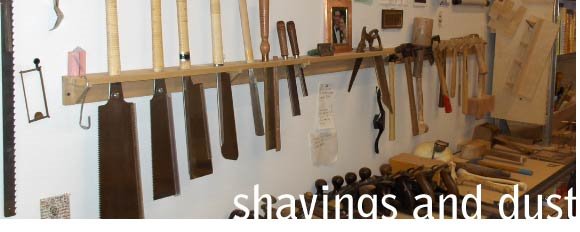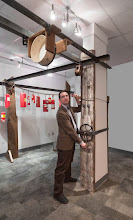We have an event on campus called S U Showcase, which showcases student work from all over the college that has happened this year. Last year, there was also an official opening of a rain garden that had just been completed on campus, that had been designed by ESF students. It happened to co-incide with the time of year that the Willow Project folks are cutting down, or "coppicing" all of the willow plants, so that they will grow back the following year. So we got some of the willow up here and I worked with faculty and staff and students to make a hollow form to celebrate the garden. We all had fun (though it was cold and rainy), and the end result was pretty good.
 |
| Alexandra Fiust and I getting the basic structure in place. |
One of the things that happens when you are doing something weird in public (like on the quad of a university) is that passersby fall in to one of three general categories: 1) too cool to even acknowledge that anything is going on; 2) interested but unwilling to engage, afraid that they will be tainted somehow by the weirdness; or 3) interested and engaged and willing to jump in and be weird as well. It is interesting to me how many people fall in to category 2. We had a bunch of people who stopped and watched, but when I asked them to weave a twig in they backed away as if I were handing them a basketful of slugs. These folks are the well-trained products of a system and culture that teaches us that we can not be makers, that we have somehow been divested of permission to be a part of a creative experience unless we are specifically trained to do so.
But then there were fair number of people who fell in to category 3, who grabbed a twig and added it to the form. One only needs hands to make this kind of thing, so no knowledge of special tools or techniques is required. I tell folks that the only rule is that they weave the twig in , and if it stays, they have done it right. They usually laugh and say something about how they will probably ruin the structure, to which I usually crack wise and try to get them to laugh, so that they are more at ease. Some people actually get into the process and start to weave more and more twigs in, which is when I really feel like things are progressing well. I got to meet a lot of people on the quad yesterday morning, people I would never have met otherwise. I met a Spanish teacher, an art historian, a grad student who is the assistant coach for the cross-country track and field team, the administrative assistant of the math department. Once they understood that there were no rules, that the twigs just get woven in and that is that, they were a lot more likely to join in. Which was the point, after all.
 |
| The finished structure. |



1 comment:
Thanks for this, Zeke. I think those of us in the education biz need to keep reminding ourselves that the way to reach hearts and minds often starts with the hands.
Post a Comment